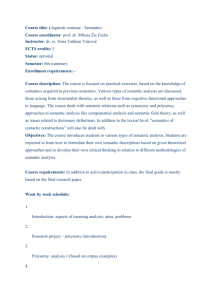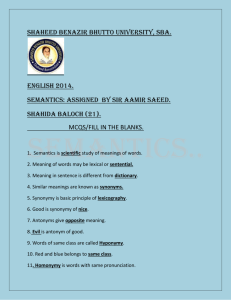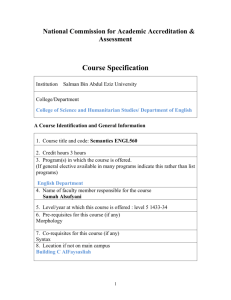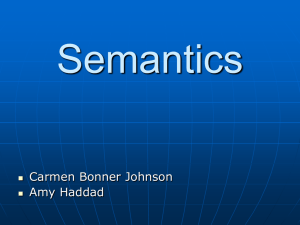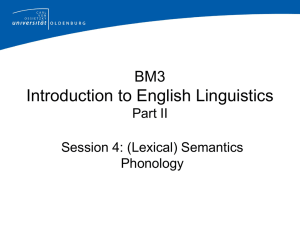SYLLABUS COURSE TITLE Semantics and Lexicology Faculty
advertisement
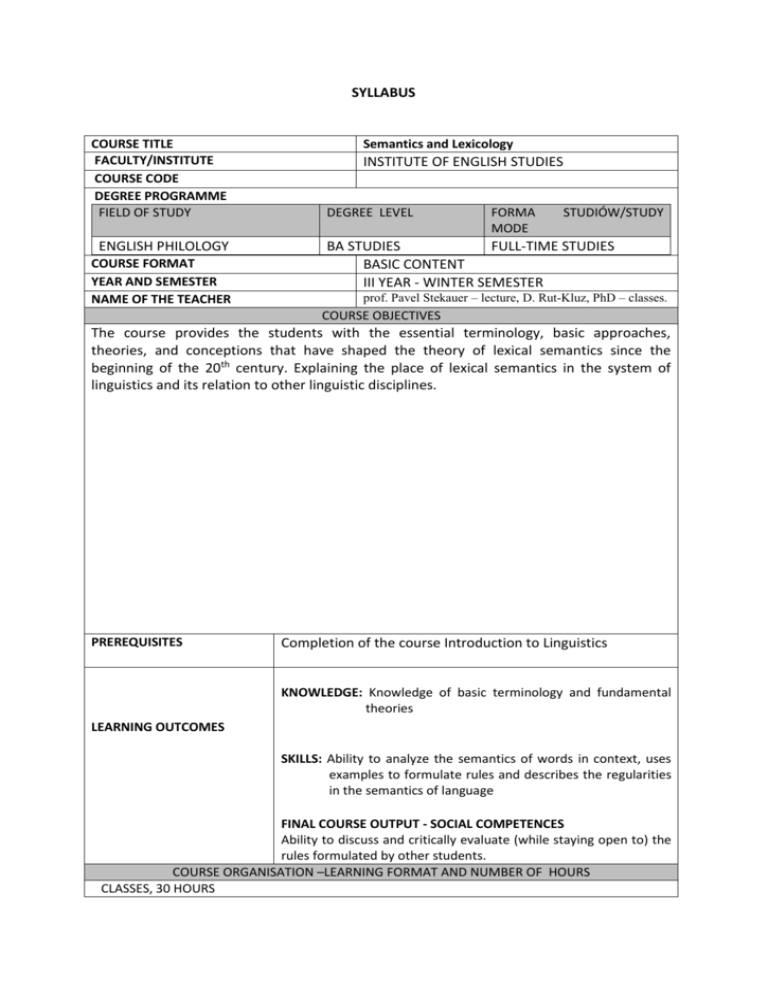
SYLLABUS COURSE TITLE FACULTY/INSTITUTE COURSE CODE DEGREE PROGRAMME FIELD OF STUDY ENGLISH PHILOLOGY COURSE FORMAT YEAR AND SEMESTER NAME OF THE TEACHER Semantics and Lexicology INSTITUTE OF ENGLISH STUDIES DEGREE LEVEL FORMA MODE STUDIÓW/STUDY BA STUDIES FULL-TIME STUDIES BASIC CONTENT III YEAR - WINTER SEMESTER prof. Pavel Stekauer – lecture, D. Rut-Kluz, PhD – classes. COURSE OBJECTIVES The course provides the students with the essential terminology, basic approaches, theories, and conceptions that have shaped the theory of lexical semantics since the beginning of the 20th century. Explaining the place of lexical semantics in the system of linguistics and its relation to other linguistic disciplines. PREREQUISITES Completion of the course Introduction to Linguistics KNOWLEDGE: Knowledge of basic terminology and fundamental theories LEARNING OUTCOMES SKILLS: Ability to analyze the semantics of words in context, uses examples to formulate rules and describes the regularities in the semantics of language FINAL COURSE OUTPUT - SOCIAL COMPETENCES Ability to discuss and critically evaluate (while staying open to) the rules formulated by other students. COURSE ORGANISATION –LEARNING FORMAT AND NUMBER OF HOURS CLASSES, 30 HOURS COURSE DESCRIPTION Lectures: 1. Linguistic sign (de Saussure’s theory, the principles of arbitrariness, linearity, discreteness (discontinuity), semiotic triangle – denotation, designation, signification; denotative (cognitive) meaning, connotative meaning (associative), connotative-stylistic types (territorial, social, stylistic proper, temporal), referent 2. Lexical units (delimitation; semantic constituents, principle of compositionality, definition of the semantic constituent, minimal semantic constituent, test of recurrent semantic contrast). Word (different approaches to the notion of word, Di Sciullo & Williams, Matthews; criteria for the delimitation of word; the notion of paradigm 3. Word-meaning – affinities – paradigmatic and syntagmatic; semantic traits – statuses, fixed meaning theory, core-meaning theory, fuzzy edge theory, prototype theory, semantic primitives – componential analysis, semantic networks 4. Idioms (phrasemes), collocations, and dead metaphors (basic features of idioms; the notion of transparency and opacity, degrees of opacity, semantic cohesion in collocations). 5. Influence of context on the meaning of words (selection and modulation, promotion, demotion, highlighting, backgrounding, transfer features, semantic cooccurrence restrictions – selectional and collocational restrictions, Katz and Fodor’s approach to the context in a semantic theory 6. Lexical relations (four general types of relations – identity, inclusion, overlap, disjunction and their lexical counterparts; quasi-relations; synonymy – cognitive synonymy, tautonyms, homonymy – criteria for the delimitation of homonymy with regard to polysemy, faux amis, 3 types of antonymy, hyponymy 7. Lexical configurations (hierarchies, branching, non-branching relations, relations of dominance and difference, asymmetric relation, catenary relation, transitivity & intransitivity), the notion of lexical field, Trier; doublets, meronomy, assymetry and gaps 8. Componential analysis and relational components (semantic components, logical constants, implicational rules, redundancy notations, propositions and arguments, complex relations) 9. Typology of features (origins of the theory of features, distinctive features within the phonological theory of the Prague school of Linguistics; denotative, connotative, transfer, relational, deictic features, inferential features) 10. Katz and Fodor’s semantic theory (scope of a semantic theory, the role of context, components of the semantic theory – dictionary, projection rules, dictionary entries, sense characterization, semantic markers, distinguishers 11. Cognitive semantics – general, meaning and semantic nature, conceptualization and imagery, the nature of grammar, continuum of symbolic structures, schemas, categorizing relationships, compositional and actual semantic values, grammar as a symbolic phenomenon, component and composite structures, degrees of schematicity, constructional schemas, schematic transparency principle 12. Pragmatic, corpus-based approach to lexicography 13. Change of meaning (1. logic-based changes (extension, restriction and branching of meaning; 2. transfer of meaning (metaphor, metonymy, synecdoche). Changes due to (a) reality, (b) conflict in the system, (c) folk etymology, (d) calques Revision Classes: Numer of hours 1. Lexicology and semantics, relation of the fields 2. Meaning and concept 1 2 3. General vocabulary and specialized terminology 2 4. Types of meaning (descriptive and non-descriptive) 2 5. Lexicon; its elements and the relations among them (np. hyponymy, synonymy, opposites) 6. Word formation processes 8 7. Methodology of semantic investigation 2 8. Semantic fields 2 9. Homonymy a polysemy 2 10. Cognitive semantics: prototypes, frames, scripts, metaphor i metonymy 11. Test 6 1 METHODS OF INSTRUCTION REQUIREMENTS AND ASSESSMENTS GRADING SYSTEM TOTAL STUDENT WORKLOAD NEEDED TO ACHIEVE EXPECTED LEARNING OUTCOMES EXPRESSED IN TIME AND ECTS CREDIT POINTS LANGUAGE OF INSTRUCTION INTERNSHIP MATERIALS 2 Total time: 30h Lecture. In class discussion, working with examples (either own or provided by the teacher) in groups or individually Lecture: written exam Classes: written test To complete the course one needs to Lecture: attend the lectures and score 60% of the total points on the written exam. Classes: attend the classes and score 60% of the total points on the test. 70 hours, 2 ECTS, ENGLISH NONE LECTURES PRIMARY OR REQUIRED BOOKS/READINGS: 1. Lectures 2. Štekauer, P. (1993) Essentials of English Linguistics. Prešov: Slovacontact. 3. Štekauer, P. (ed.) (2000) Rudiments of English Linguistics, Prešov: Slovacontact. (chapters 2, 3, and 4) SUPPLEMENTAL OR OPTIONAL BOOKS/READINGS: Friedrich Ungerer and Hans-Jörg Schmid. 1996. An introduction to cognitive linguistics L. Lipka. 2002. English Lexicology. Tubingen: Narr D. Geererts. Theories of Lexical Semantics. 2009. Oxford: Oxford University Press. CLASSES PRIMARY OR REQUIRED BOOKS/READINGS: 1. Burkhanov, I. 1998 Lexicography. A Dictionary of Basic Terminology. Rzeszów: Wydawnictwo Wyższej Szkoły Pedagogicznej w Rzeszowie 2. Lyons, J. 1977 Semantics. Vol.1, 2 Cambridge: Cambridge University Press. SUPPLEMENTAL OR OPTIONAL BOOKS/READINGS: 1. Cruse, D. A. 1991 Lexical Semantics. Cambridge: Cambridge University Press. 2. Lyons, J. 1996 Linguistic Semantics. An Introduction. Cambridge: Cambridge University Press.
